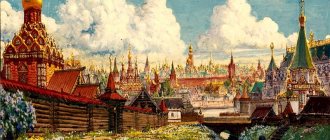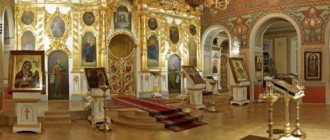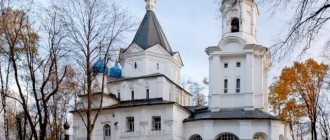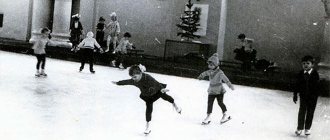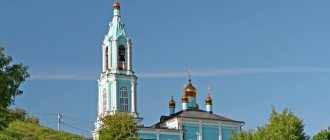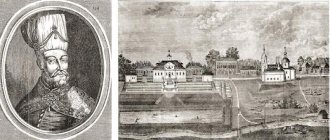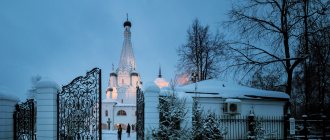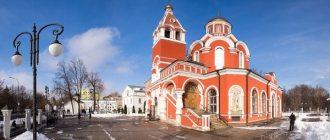Back in 1874, Tikhoretsk was a railway station. Over time, a farmstead was formed here, then a regional center, and in 1926 it was given the status of a city. The spiritual needs of the population also grew. At first, residents invited a priest from a neighboring village, and then turned to the diocesan administration with a request to build a church, which was the predecessor of the Holy Assumption Church.
History of construction
At the very beginning of the 20th century. Tikhoretsk consisted of 2 territorially independent parts: the Tikhoretsky farm (at that time more than 2 thousand people lived there), which was administratively subordinate to the village of Fastovetskaya, and the Tikhoretskaya station, which was owned by the Vladikavkaz Railway.
There was no clear division between them, but these 2 areas had only one small old wooden St. Nicholas Church, and it was located at the Tikhoretskaya station.
Holy Dormition Church in Tikhoretsk
This circumstance became the reason that in the summer of 1907 the residents of the farm sent their appeal to the spiritual consistory of Stavropol with a request to allow them to open a new temple on their own territory. To do this, the farmers asked to sell it to them for 3 thousand rubles. the old St. Nicholas Church built in 1896, located at the Tikhoretsk railway station. Their request was granted.
The best place was allocated for the construction of a new church on the farm, where on 04/05/1909 the foundation stone of a temple in honor of the Mother of God took place as a memory of her Dormition.
The new temple building and bell tower were built of brick. Only the dome and figure of eight were made of wood. A 2-tier oak iconostasis was installed inside. At the end of December 1910 (01/09/1911 BC) the consecration of the church took place. Its first rector was Alexander Rozhdestvensky, a graduate of the Novgorod theological seminary.
The Holy Dormition Church in Tikhoretsk was active until the end of the 30s. last century. In 1937 it was closed and turned into a grain storage facility. However, in 1942, the Assumption Church resumed its activities again. This was explained by the loyal policy of the German command in relation to the functioning of Orthodox churches in the occupied territories.
The post-war years were also difficult for the temple. Over the course of a quarter of a century, it has had more than 10 abbots, and they have tried to close it more than once. Nevertheless, he became one of the few in Kuban that remained active.
A new stage in the life of the Assumption Church began in 1970 with the arrival of a new rector, Peter Dashevsky, who devoted more than 30 years of his life to pastoral service.
At this time, they began to improve the temple: they made repairs to the building, updated and supplemented the internal wall paintings. In addition, they expanded its territory and built a utility building, which housed a Sunday school and a library.
Holy Dormition Church in 2000
Peter Dashevsky was buried on the territory of the temple.
History[edit]
On August 22, 1907, residents of the Tikhoretsky farm turned to the Bishop of Stavropol and Ekaterinodar Agathodorus for permission to build a temple. A gathering of residents decided to buy the old St. Nicholas Church, which was to be demolished, located on the territory of the Tikhoretskaya railway station, and on April 5, 1909, the foundation stone for the church in honor of the Dormition of the Blessed Virgin Mary was completed.
On December 27, 1910 (January 9, 1911 according to the new style), the new church was consecrated. The building was built of brick on a stone foundation, the octagon and dome were wooden. Two-tier oak iconostasis. The bell tower is brick.
The first rector was priest Alexander Rozhdestvensky, born in 1878, a graduate of the Novgorod Theological Seminary. In 1917, he was confirmed as dean of the Tikhoretsk district.
In 1937, the clergy of the Assumption Church were arrested on suspicion of counter-revolutionary agitation. The temple was turned into a grain warehouse.
In 1942, during the German occupation of the city of Tikhoretsk, services began to be held in the temple again (the temple was officially opened in 1944).
One of the first priests of the newly opened church was Archpriest Mikhail Minoransky. Being the rector of the church in the city of Tikhoretsk during the Patriotic War, he carried out patriotic work, as a result of which during 1943-1945. collected more than 100 thousand rubles and donated them to the country's defense fund and to help disabled people and the families of those killed at the front. During the period the Germans were in Kuban, he did not compromise himself. For his patriotic service, Father Mikhail was awarded the medal “For Valiant Labor in the Great Patriotic War of 1941-1945.”
Over the next twenty-five years, there were repeated attempts to close the temple; more than ten abbots were replaced. At the height of Khrushchev’s persecutions, the Assumption Church remained one of the few operating churches on the territory of Kuban.
1970 – special for the Holy Dormition Church. With the appointment of the rector of Archpriest Peter Dashevsky to the Tikhoretsk land, a new historical milestone began. During the 33 years of Father Peter's pastoral ministry, the temple was repeatedly repaired, new paintings were created inside the church, the territory was expanded, a utility building was built, which housed the church library and Sunday school. For his patriotic and peacekeeping activities, Father Peter was awarded the honorary badge of the Regional Peace Committee. Father reposed in the Lord on the Feast of the Exaltation of the Holy Cross of the Lord on September 27, 2006. The rector was buried at the altar wall of the Holy Dormition Church.
On May 31, 1991, Archbishop Isidor of Krasnodar and Kuban consecrated a new altar in the Holy Dormition Church in Tikhoretsk.
On January 1, 2003, Archpriest Andrei Dashevsky was appointed rector.
On January 9, 2011, the temple celebrated its 100th anniversary. On this day, Metropolitan Isidor of Ekaterinodar and Kuban re-consecrated the temple after a major renovation.
Holy Dormition Church today
In 2007, major renovations began in the temple complex.
A lot of work has been done:
- new windows installed;
- instead of the old central dome, they installed a new one made of titanium nitride, updated the base for the cross and installed a new 5-meter cross, also made of shining titanium nitride;
- the dome vault was replaced with a new one made of fiberglass with painting;
- new portals were built at the entrances, the altar was expanded, the painting on it was updated and a new sexton building was added;
- the roof and floors were replaced, tiles were laid, mosaic paintings appeared on the portals of the temple;
- Heating systems, gas pipelines and electrical wiring were replaced.
During the renovation, the original carved oak iconostasis, the work of masters from the beginning of the last century, was restored. The restoration work was carried out by workers from the Stavropol Pakhomov Workshop.
To prepare the unique pre-revolutionary iconostasis for applying gold leaf to its surface, the craftsmen had to first remove more than 20 layers of old paint from it, which took almost 2 months. For the updated iconostasis, icon painters from Krasnodar Oleg and Lyudmila Nemtsov painted 13 new icons.
A new painting of the altar was also done. The prepared ceilings of the central part and aisles will also be painted in the near future.
In addition, the tent and dome on the bell tower were replaced, and new ceilings between floors were made inside the structure. A very beautiful staircase leading to the choir has been installed. The pillars supporting it are decorated with amazingly beautiful forged olive branches made by Vladimir Cherny.
Forged railings and gratings at the entrance to the altar, created by the same master, were placed on both sides of the central and side entrances to the temple. Also, a new belfry was made on the bell tower, consisting of 8 bells. The bells, cast specifically for the Assumption Church, were brought from Voronezh in the summer of 2010. The order was completed in the workshop of Oleg Radchenko.
The largest bell, made with donations from the St. Nicholas Foundation, weighs 1300 kg. It was cast in honor of Jesus Christ. A 430-kilogram bell was made in memory of the Mother of God. The rest, made at the expense of parishioners, weigh 4, 8, 16, 20, 30 and 62 kg.
And this is only part of the work that was carried out. After the renovation, the temple building acquired a new look also due to the change in color of the outer walls. They are now painted a soft blue, fading into a darker blue in places and blue on the portals.
Other objects of the temple complex
On the territory of the temple there is a recently opened Spiritual and Educational Center, bookstores, church shops, and a library.
Spiritual and educational center
The spiritual and educational center, opened several years ago on the territory of the temple, was built exclusively with funds from the parish and private donors. The buildings of the center form a single architectural ensemble with the Iverskaya Chapel over the gable.
At one time, the design of the chapel, now rising above the ancient church well, was carried out by S. Sergeeva and E. Yozhikova. The chapel was erected in honor of the Iveron image of the Blessed Virgin Mary.
The two-story building of the center, located to the left of the chapel, housed the refectory and classrooms of a comprehensive primary school. In the building located to the right of the chapel, there are housekeeping services, a radio studio, a kitchen room, a room for the priest on duty and much more.
The Sunday school and library have resumed their work in the center's buildings, and an assembly hall has been opened.
Book store
In the vestibule of the temple there is a bookstore, open on Sundays and holidays. There are several hundred books on sale on various topics. Religious literature is carefully selected and aimed at parishioners of different ages.
Among ordinary books there is always literature with large print, which is suitable for people with poor eyesight. If the publication you need is not on sale, you can always order it from the store.
Parish library
There is a library at the church from Wednesday to Sunday inclusive from 10:00 to 14:00. It first opened in the summer of 2001. The book fund was based on books donated by Peter Dashevsky, then rector of the Assumption Church.
921 copies were accepted as a gift. Now the library has more than 5 thousand books. At the same time, the book collection is diverse and unique. There are many copies here that are bibliographical rarities. In addition to books, the library contains a large number of titles of periodicals (newspapers, magazines) with spiritual content.
Church shop
In the courtyard of the temple there is a small building of a church shop. It is open daily from 7 am to 7 pm. Here you can purchase various church items (candles, lamps, icons, spiritual literature). In addition, the shop accepts orders for prayers, memorial services and other services.
Temple shrines
The Holy Dormition Church in Tikhoretsk contains many shrines. These are icons and relics of saints.
Icons:
- “Assumption of the Mother of God” (temple);
- Our Lady “All-Tsarina” or “Pantanassa” (written especially for the Tikhoretsk church and brought in 2013 from the Vatopedi monastery);
- healer Panteleimon;
- St. Nicholas the Wonderworker;
- Iverskaya Mother of God;
- Seraphim of Sarov;
- St. St. George the Victorious;
- Xenia of Petersburg and part of the saint’s tombstone;
- Confessor Luke of Crimea;
- Matrona of Moscow;
- Alexander Nevsky.
The reliquaries of the last 3 icons contain particles of the relics of these saints. Also in the cathedral there is a shrine with the relics of such saints: the healer Panteleimon, Tikhon of Zadonsk, Alexander of Sanaksar, Job of Pochaev, John Chrysostom, John of Kormyansky and other saints.
Temple shrines and modern times
Pilgrims go to the Church of the Assumption to touch the shrines, pray, light candles, and submit notes. The following objects of holiness and faith are stored here:
- icon of the Mother of God, called “The All-Tsarina”;
- reliquary ark with particles of many saints;
- ark with a piece of the relics of the torment. Tatiana;
- image with a particle of the tombstone of the blessed one. Xenia of Petersburg;
- icons revered in the temple: “The Dormition of the Blessed Virgin Mary”, St. Nicholas the Wonderworker, Seraphim of Sarov, St. George the Victorious, “Iverskaya”.
- face of the arch. Luke Voino-Yasenetsky (Crimean), Prince Alexander Nevsky, Matrona of Moscow with reliquaries.
A few words need to be said about the icon “The Tsaritsa”. This is a copy of the miraculous icon of the same name, which is kept on Holy Mount Athos (Greece), in the Vatopedi monastery. It was made specifically for the Holy Assumption Cathedral and consecrated on Mount Athos, near the original.
The self-name “Vsetsaritsa” speaks of her importance in heaven and earth. The Mother of God is revered in many countries. Orthodox Christians consider her their intercessor before God. She gained her fame when, after praying before her, cases of healing from oncology occurred.
Since then, lists of icons began to be placed in cancer centers in different cities and countries. In the Holy Dormition Church on weekdays, before the venerated image, a prayer service is performed with the reading of an akathist.
Holy Assumption Cathedral today
Since October 2021, after the consecration by Bishop Stefan of Tikhoretsky, a Spiritual and Educational Center has been operating at the church for teaching children and adults. Archpriest Andrei Dashevsky is both the church rector and a Sunday school teacher. There are 4 priests in total.
Well, now about especially honored days:
- August 28 - Dormition of the Virgin Mary (patronal feast), on the 27th the shroud is taken out at the evening service;
- November 19 is the day on which the icon was brought from Athos; its townspeople and tourists who came here celebrate with a religious procession.
Clergy, mentors
The cathedral received its status as a cathedral in March 2013. This happened after the formation of the Tikhoretsk diocese, which was part of the Kuban Metropolis. The temple staff consists of 6 people. The clergy is led by Bishop Stefan of Tikhoretsky and Korenovsky (Kavtarashvili Andrey Labazovich).
| First Name Last Name | Education | In state | Responsibilities (obediences) |
| Kavtarashvili A. L. (Stephan) | Theological Seminary (Stavropol), Theological Academy (Kyiv) | from 2021 | Rector of the Holy Dormition Cathedral Church |
| Priest E. Ilyin | Pererva Theological Seminary | since 2009 | • secretary of the diocesan administration; • interaction with gymnasium No. 8; • is responsible for the operation of the parish website. |
| Priest A. Topov | Theological Seminary (Odessa), Theological Academy (St. Petersburg) | since 2014 | • work with preschool institutions; • organization of work in Sunday school for adults. |
| Priest A. Reutov | Ekaterinodar Theological Seminary | from 2021 | • deals with issues of family protection, motherhood and childhood; • is responsible for working with preschool institutions. |
| Priest N. Burduli | Theological Seminary (Stavropol) | from 2021 | – |
| V. Sushko | Theological Seminary (Stavropol) | from 2021 | diocesan protodeacon |
Social work, everyday life
Thanks to the donations and efforts of the church workers, a church-chapel in honor of Christ's Resurrection was erected at the Tikhoretsky cemetery (its opening hours are from 10:00 to 14:00).
Social service
The parish actively cooperates with the city administration, departments of social protection and guardianship, and bodies supervising education in the area. The priests of the Assumption Cathedral constantly visit the maternity hospital and city hospital. Here, in each department, they have organized libraries where spiritual literature is selected and conversations are held.
The temple servants also supervise the pre-trial detention center and the society of the blind (Tikhoretsky branch). A trip to holy places was organized for the visually impaired, which allowed them to become better acquainted with the world of Orthodoxy and church music.
Every week, in the courtyard of the temple, baby food and clothing are distributed to low-income families.
Educational activities
The temple servants carry out spiritual and educational work with preschool and secondary educational institutions. Thanks to the priests and church staff, a course called “Fundamentals of Orthodox Culture” has been organized in Tikhoretsk schools.
The course is taught to students:
- as an educational subject;
- in the form of an elective, club work for younger schoolchildren;
- For students in grades 10–11, the course is taught as an elective subject.
Teachers who teach the school defense education course also receive spiritual education.
Current state[edit]
The clergy and employees of the temple conduct active spiritual, educational and social activities on the territory of the temple and beyond.
The parish library is open on the territory of the church every day, except Monday and Tuesday, from 10 a.m. to 2 p.m.
Also on the territory of the temple daily from 7 to 19 hours. There is a church shop where you can buy candles, various church utensils (icons, lamps), gold and silver crosses and chains for baptism, spiritual literature, audio and video cassettes, as well as order prayer services, memorial services, magpies and other services.
The workers of the Holy Dormition Church, at the expense of the parish and donors, built a church-chapel in honor of the Resurrection of Christ at the city cemetery. The consecration was performed on November 12, 2006 by Metropolitan Isidor of Ekaterinodar and Kuban. This temple, built over 2 years, is not only a symbol of our faith in the future resurrection of the deceased residents of the city, among whom there are people dear to us, but also a place where prayers are regularly offered for their repose.
The Temple-Chapel is open daily from 10 a.m. to 2 p.m.
The parish of the Holy Dormition Church works closely with the city administration, employees of the social protection department of the city and district, the education department of the Tikhoretsky district, the district youth policy department, and guardianship authorities. With the active participation of the priests of the Holy Dormition Church, various actions and events of a social nature are carried out.
The priests of the Holy Dormition Church regularly visit and sprinkle holy water on the city hospital and maternity hospital in Tikhoretsk, where small libraries have been created in each department, conversations are held with medical staff and the sick, and icons are distributed to the sick for prayerful reinforcement.
Every year, with a festive Christmas concert, toys and sweet gifts, students from secondary school No. 2, together with their teachers and spiritual mentor Priest Dionisy Zuban, visit the Bereginya orphanage.
Priest Alexander Korneev takes care of the pre-trial detention center, where he conducts conversations with prisoners on moral and theological topics, the Sacraments of Confession and Communion. For the spiritual edification of prisoners, a small selection of church books has been collected, where they could find consolation and moral edification in searching for ways of spiritual perfection.
Round tables are held with the participation of priests, where pressing problems of modern society are discussed and the spiritual understanding of holidays, both church and secular, is revealed.
Warm and close relations have been established with the Tikhoretsky branch of the Society of the Blind. Meetings between the priest and the visually impaired are confidential and simple. An icon of the Kazan Mother of God, the patroness of those suffering from vision, was presented.
Clothes and baby food are distributed weekly to low-income families on the temple grounds.
Service schedule, operating hours
Divine services in the church are held every day: in the morning at 7 o'clock and in the evening at 17 o'clock. The Sacrament of Communion takes place every day after the morning service. After the evening service, confession is performed on all days of the week. The weak and those who come from settlements that do not have their own churches confess in the morning.
At 16:00 on Sunday and at 12:00 from Monday to Friday inclusive, a prayer service is held in front of the icon of the Mother of God “The Tsaritsa”. On New Year's Eve every year the Divine Liturgy is celebrated.
Interesting facts about the temple
The Holy Dormition Church in Tikhoretsk has a centuries-old history.
During this time, many interesting and surprising events happened, connected both with the temple itself and with its arrival:
- So, for example, when purchasing the old St. Nicholas Church, its iconostasis was also purchased. Therefore, after the construction of the Assumption Cathedral, instead of the icon of the Dormition of the Mother of God, for some time there was an image of St. Nicholas of Myra, which contradicted the temple Charter.
- During the Great Patriotic War, the rector of the temple was M. Minoransky, who during this difficult period carried out active patriotic activities among his parishioners. Over the two war years, under his leadership, more than 100 thousand rubles were collected. These funds were intended to provide material support to disabled people and families of the victims.
There was such a temple in Tikhoretsk
Back in 2008, on the eve of the 100th anniversary of the St. Nicholas Church of the Tikhoretskaya station, several publications were published dedicated to this event.
The most interesting were articles by Tatiana KRAVETS, dedicated to the first priest of the Tikhoretskaya station and the history of the construction of a wooden and later stone church, and the memoirs of the now deceased Tikhoretsk poetess Galina STRIZHAKOVA, who saw the temple burn during the occupation of the city by the Nazis in January 1943.
And the station land heard the prayer
This was in 1874. In the Kuban steppe, the Vladikavkaz railway and a small railway station were built, which received its name from the village of the same name Tikhoretskaya (now Fastovetskaya).
Initially, in the absence of a temple, prayers were offered only in front of household images, but with the increase in the population of the station, the need for cathedral prayer arose.
And soon after 1877, station employees began to invite a priest from the village of Tikhoretskaya. In 1879, at the request of the serving clergy of this village, he gave them the Kazan Icon of the Blessed Virgin Mary from his church. And in April 1887, with donated money, instead of this icon, another one was purchased - St. Nicholas the Wonderworker. It was placed in the station building so that employees and passengers could place candles in front of the image.
The first church was wooden
On October 1, 1894, Bishop Agafodor of Stavropol and Yekaterinodar appointed priest Alexander Kudrin and psalm-reader Pavel Kondratov to the parish of the Tikhoretskaya station. The 3rd class hall in the station building became a temporary place for worship.
The first church was built and consecrated on August 30, 1896 in honor and memory of the transfer of the relics of St. Nicholas the Wonderworker of Myra. It was wooden, on a stone foundation, plastered inside and lined with brick outside, cold and without a bell tower, and could accommodate no more than 300 people.
In 1905, parishioners came up with a proposal to build a stone temple within the church fence. The memory has saved everything
On December 28, 1908, the new church was consecrated by Archbishop Agafodor of Stavropol and Ekaterinodar. At that time, the St. Nicholas Church was the largest on Tikhoretsk land.
Its building was brick with concrete vaults, the walls were painted, the iconostasis was concrete-marble-mosaic, the floor was made of colored concrete tiles. The temple could accommodate up to one and a half thousand people.
For 29 years, the church bell of the St. Nicholas Church has been gathering parishioners for prayer. The parish ceased to exist only in 1937 due to the arrest of the clergy. Later the premises were converted into a club. The rector of the temple, Alexander Kudrin, was shot. During the Great Patriotic War, the building was badly damaged, and after the war the temple was blown up and completely destroyed. Subsequently, a railway technical school complex was erected on the temple territory.
But the temple has preserved our memory.
Father Alexander Kudrin
The life of the first priest of Tikhoretsk, Alexander Kudrin, is amazing. Not everyone manages to start a good cause, live, work with their parishioners and, in the Gospel, give their life for the Faith, for people, for the cause they honestly served.
Alexander Kudrin was born on December 9, 1868 in the family of a peasant in the Stavropol province. After graduating from the Stavropol Theological Seminary, he served as a psalm-reader and deacon-teacher in the churches of the Stavropol province. On September 27, 1894, he was appointed priest to the St. Nicholas parish. Tikhoretskaya.
In the station village, the 26-year-old priest took on any task: performed divine services, sacraments, performed religious services, supervised the construction of the wooden, and then the first stone St. Nicholas Church. Priest Alexander Kudrin took part in the first general population census, and also taught first at a two-grade railway school, and later at an eight-grade commercial school of the Ministry of Trade and Industry.
Father Alexander raised five daughters and two sons (all children, except his daughter Lyudmila, were born on Tikhoretsk land).
The priest’s wife, Tatyana Ivanovna, helped and supported him in everything.
But then came 1917. The time when churches were destroyed and faith in God was eradicated. The revolution and civil war fell on the confused people, when the father fought against his son, the son against his father and brother... All this was difficult to fit into the minds of people, and many of them went for help to the temple, to the priest whom they trusted, along with to whom they prayed. And Father Alexander again taught his parishioners to love each other, not to kill, not to rob, but to endure difficulties and trust in God. After Father Alexander’s sermons, people left the church with pure hearts and enlightened souls. But a black cloud hung over the Tikhoretsk church. The new government forbade going to services, praying, and baptizing children, but the church was not empty.
In 1923, priest Alexander Kudrin was first arrested by the NKVD and was kept in custody for four months. Ten years later, the arrest was repeated again in the case of the seizure of temple valuables. But due to lack of evidence of guilt, Father Kudrin is again released. The third arrest for 70-year-old priest Alexander Kudrin became fatal. In 1937, the NKVD in the Krasnodar Territory made a decision typical for the year of severe repression. On January 10, 1938, priest Alexander Kudrin was shot. The shepherd’s heart stopped beating, the doors of the temple he built and prayed for were closed.
But was the work to which God’s providence gave the priest the opportunity to give his life destroyed? Of course not. It was continued by the priests of the Holy Dormition Church.
I saw the temple burn
What do I know about the first stone church in Tikhoretsk?
My childhood years were spent in the courtyard of a house that stood on the corner of Klubnaya (now Chernysheva) and Krasnoarmeyskaya streets. Opposite our windows, across the road, there was a large stone temple. The temple courtyard occupied almost the entire block.
From the memoirs of my Aunt Lena, I learned that before the revolution, services were held in the temple. One of the priests was Kudrin, a highly educated man whom the parishioners greatly respected. In the courtyard of the temple there were graves of deceased clergy. After the revolution, the temple was closed, the priests were arrested, the building was turned into a club and called “Red October”.
During the occupation, in the fall of 1942, the Germans posted notices around the city that a film would be shown at the club, and then dances would be organized for young people. I was 12 years old, about the same age as the other children from our yard. We persuaded our parents to let us see the film. A lot of young people gathered. After watching the film, we teenagers returned home. But the older youth - those who stayed for the dance - did not return home. The Germans sent them to work in Germany.
At the end of January 1943, the Nazis burned the temple. On the morning of January 27, an officer and a soldier with a can appeared in the church yard, near the Oktyabrskaya school. My mother, my neighbor, and I watched them from the window. Having collected armfuls of papers, the Nazis entered the school. About 15 minutes later we came out, and flames were blazing out of the windows. They did the same with the railway hospital. Then we saw how the Germans headed towards the temple, entered it, and when they left, fire also began to blaze in the windows of the temple.
After the war, the temple was not restored. In 1949 I graduated from school and went to Rostov. The temple was still standing. Later my mother wrote to me that it was blown up.
In the 60s, a stadium and production workshops for secondary school No. 34 appeared in the courtyard of the destroyed temple. And then the yard was turned into a construction site for a railway technical school.
Galina Strizhakova.
Information for pilgrims
The Holy Dormition Church in the city of Tikhoretsk has been actively improving in recent years, so there is hope that in the near future a hotel for pilgrims will appear on its territory.
Now visitors can stay in hotels located nearby:
| Name | Address | Distance | Price |
| Hotel "Tikhoretsk" | st. Menshikova, 86 | 171 m | from 684 rub. |
| Hotel "Lazurit" | st. Kalinina, 112v | 1.35 km | RUB 1,955 |
| Guest House "On Engelsa" | st. Engelsa, 278 | 1.48 km | RUB 1,270 |
| Hotel "On Gogol Street" | st. Gogolya, 36/8 | 1.92 km | from 1,172 rub. |
Where is it, how to get there
The Assumption Church is registered at the following address: 352120, Russia, Krasnodar region, Tikhoretsk city, Lyapidevskogo street 2.
Its coordinates: 45.855458, 40.122308.
All necessary information about the work of the temple can be obtained by phone or email:
- tel. 8-(86196)-7-22-16;
- 8918-3428448 (priest on duty);
- e-mail: [email protected]
You can get to the temple by taxi, bus or minibus.
Stop "Engelsa Street"
The closest public transport stop to the temple (at a distance of 230 m) is “Engels Street”.
Stops here:
- buses 1, 3, 6, 7, 9, 11, 12, 14, 16, 20, 22, 24, 25, 26, 30, 33, 100, 103;
- minibuses 12a, 13, 15, 17, 18, 19, 19a, 21, 32, 109, 112, 113, 113a, 114, 115, 116, 121, 122.
There are several more stops at a distance of up to 500 m from the temple.
Stop “Civil Street” (400 m)
Stops:
- buses 1, 6, 11, 12, 14, 16, 20, 22, 24, 25, 26, 30, 33, 100, 103;
- minibuses 12a, 13, 15, 17,19, 19a, 21, 32.
Cinema Russia (430 m)
Stops here:
- buses 1, 6, 8, 11, 14, 16, 20, 24, 25, 26, 30, 33;
- minibuses 13, 15, 17, 18, 19, 19a, 32.
Kalinina Street (490 m)
The following routes pass through this stop:
- buses No. 12, 22, 100, 103, 110;
- minibuses No. 12a, 27, 101, 105, 106, 107, 108, 120.
The Holy Dormition Church, located in the city of Tikhoretsk, is revered among believers. The rich history of the parish, the remarkable architecture of the building, the large number of shrines preserved in the temple and the peaceful atmosphere that reigns around make the Assumption Cathedral a place that not only city residents, but also guests of Tikhoretsk strive to visit.
Author: Irina Zhuravka
Contacts and schedule
- Address: Lyapidevskogo street, 2, Tikhoretsk, Krasnodar region, Russia.
- GPS coordinates: 45.855468, 40.122203.
- Official website: https://www.hram-tih.ru/
- Phone: 8-86196-7-22-16.
- Schedules of services: https://www.hram-tih.ru/bogoslugeniya.html
In Tikhoretsk, the Holy Dormition Church awaits everyone who wants to venerate and pray. His icon shop sells spiritual literature, including an akathist, which is read in front of the miraculous image of the “Vsetsaritsa”. It is very beautiful in here. In the summer, no one will be indifferent to the huge rose garden growing nearby. Visitors take beautiful photos against its background. A pleasant atmosphere, silence and the fragrance of flowers distract from the elements of the world. In this place the soul strives for heaven! In conclusion, watch an educational video about him, enjoy watching!
